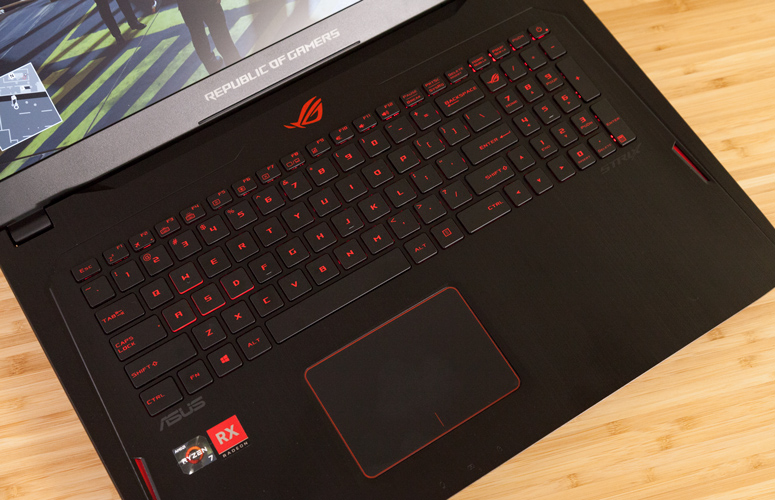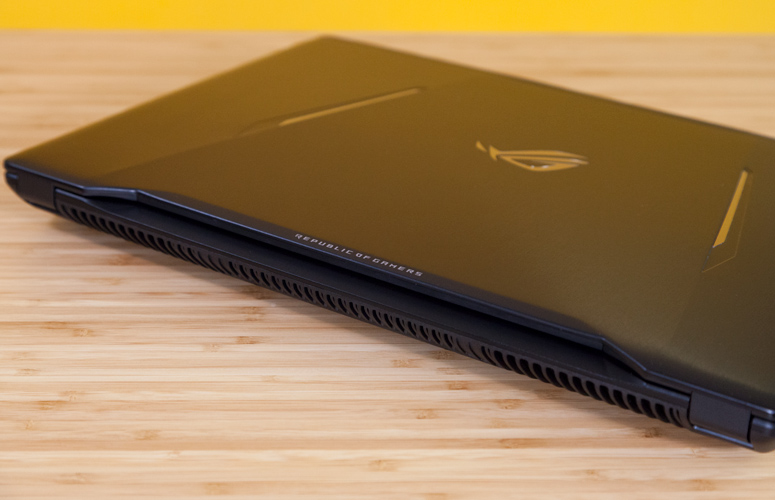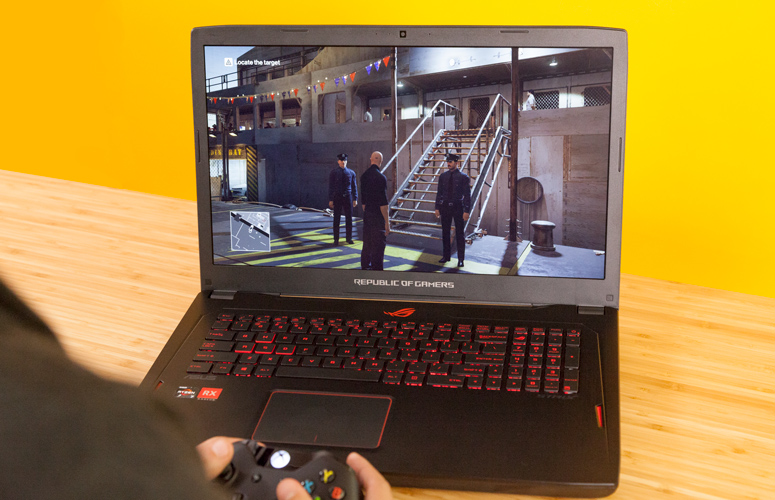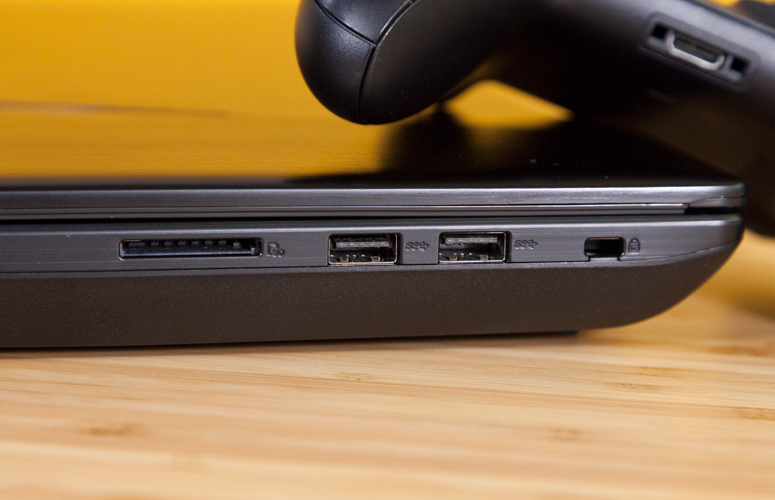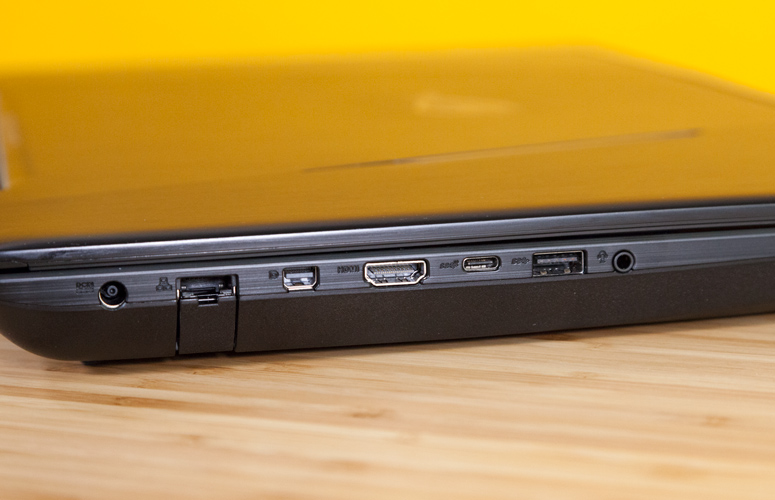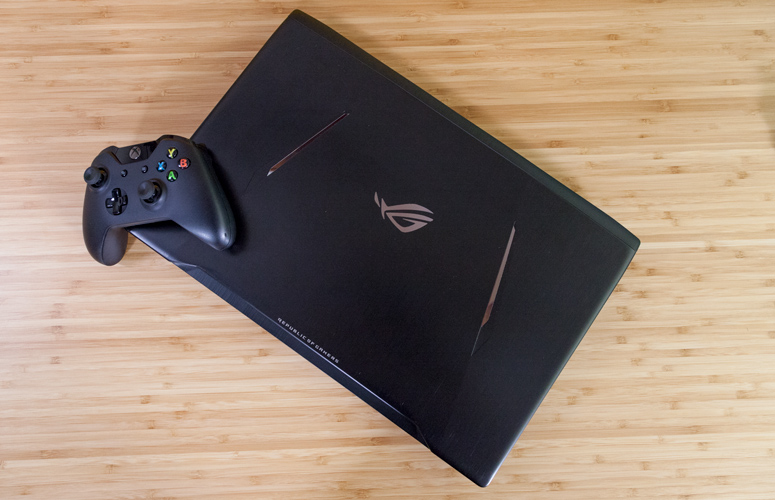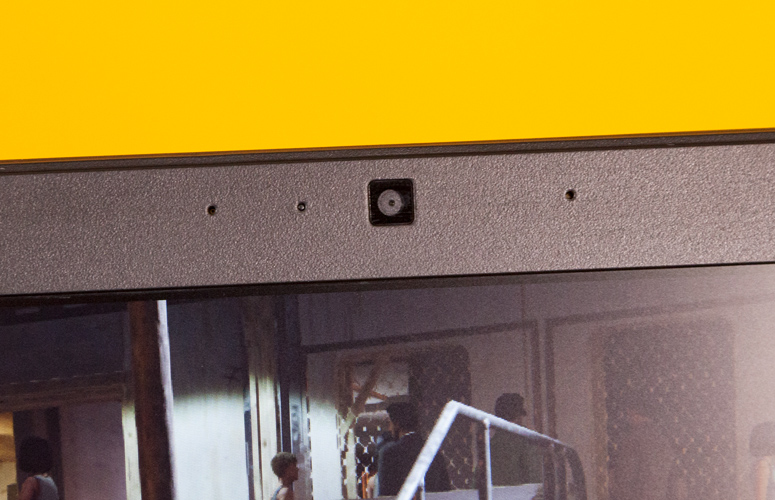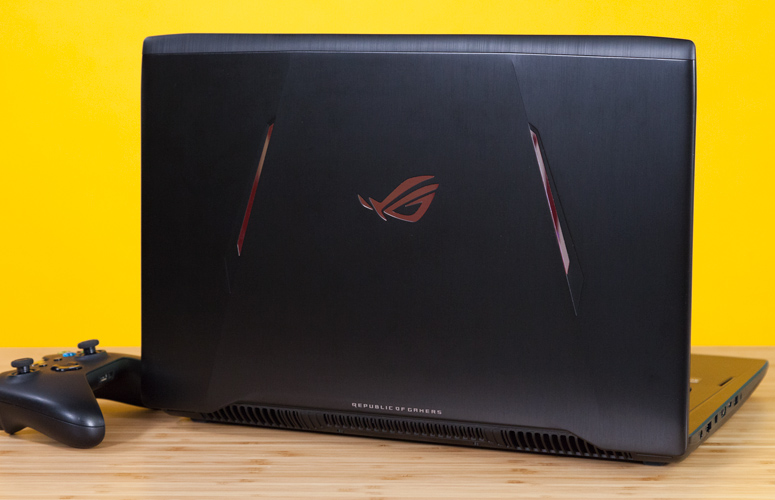Laptop Mag Verdict
The Asus ROG Strix GL702ZC has a desktop-level CPU and plays most games well, but it gets hot fast and has slow storage speeds.
Pros
- +
Powerful desktop CPU
- +
Specialized gaming software
- +
Great speakers
Cons
- -
Slow storage speeds
- -
Runs hot
- -
Dismal battery life
Why you can trust Laptop Mag
AMD diehards don't have to wait until 2018 for Ryzen Mobile on their gaming laptops. Instead, they can get an AMD chip now with the Asus ROG Strix GL702ZC ($1,499), which has the full power of a desktop Ryzen 7 1700 CPU paired with a Radeon RX580 GPU. However, with that desktop chip comes a big desktop issue: heat. You'll get some awesome speakers and a solid array of gaming hardware, but while the Strix's desktop CPU is a strong talking point, you likely won't notice its performance benefits in ordinary use.
Design
The Strix does a good job of simulating the look of a metal chassis, even though the body is plastic and feels like plastic when you touch it. I love the way the lid appears , with its faux brushed aluminum look and silver ROG logo (I'll never like that logo, but it looks its best here) adorned by reflective accent lines on either side. In addition, there's a bunch of flex in the lid; it's incredibly easy to press down.
When you lift the lid, you'll find the 17.3-inch, 1080p display surrounded by a thick bezel, a black plastic deck with orange accents and an orange ROG logo, as well as a full island-style keyboard with a number pad.
At 16.3 x 11 x 1.3 inches and 7.1 pounds, the Strix is slightly smaller than its competitors. The Origin Eon 17-X is a whopping 9.8 pounds and 16.4 x 11.6 x 1.5 inches, and the Acer Aspire V17 Nitro Black Edition is 7 pounds and 16.7 x 11.7 x 1.1 inches.
With size comes room for ports, and the Strix has room for almost every accessory or monitor you'll need. Its left side boasts an Ethernet jack, a mini DisplayPort, an HDMI output, a USB Type-C port, a USB 3.0 port and a headphone jack. The right side has a lock slot, two more USB 3.0 ports and an SD card slot.
Display
Sign up to receive The Snapshot, a free special dispatch from Laptop Mag, in your inbox.
The Strix's display is bright, sharp and quite colorful. I watched the trailer for Avengers: Infinity War, and I could see the wrinkles in Vision's skin covered by the yellow soul stone, and make out every little goosebump on Peter Parker's arm when his spider sense goes off. When I played Middle-earth: Shadow of War, I could make out the leaves on green ivy growing on the ground and see the rust growing on a cage in an Orc compound.
The screen covers a great 119 percent of the sRGB color gamut, though desktop replacements have upped the ante on displays lately, and the average sits at 130 percent. The Strix is on a par with the Aspire (118 percent) but behind the Eon (192 percent).
Asus' display is by far the brightest in its class, at 341 nits on our light meter. That's brighter than the category average (286 nits), the Eon (289 nits) and the Aspire (264 nits).
MORE: Most Anticipated Games
Keyboard and Touchpad
With just 1.3 millimeters of travel, I constantly expected to bottom out on the Strix, but I didn't. Paired with 76 grams of required force to press the keys down, it actually feels kind of bouncy, and I liked how quickly the keys popped up. There's a little bit of give in the center of the keyboard, but I was able to ignore it, typing at 108 words per minute on the 10fastfingers.com typing test (within my usual range) with my regular 2 percent error rate. My biggest complaint is that the keys are only backlit in red, while most laptops in this price range get you RGB backlighting.
The 4.1 x 2.8-inch touchpad is smooth and responsive, even when you have to get your mouse across the mammoth 17-inch display. It was quick to react to gestures, like flicking three fingers to show all of my open windows as well as my usual two-finger scrolling.
Audio
It's been a long time since I used a computer with speakers that sound this good on the low end. When I listened to Adele's "Set Fire To The Rain," the bass was clear as the sound filled our midsize conference room. With a few adjustments to vocal quality and reverb in the included Sonic Radar Studio app, I was truly satisfied with the sound. The guitars, keyboards, drums and bass were especially detailed as was Adele's booming voice.
The speakers made games sound great, too. When I played Shadow of War, the orchestral music sounded amazing/. I could even make out the little detailed sounds like footsteps on a muddy path. But despite the loud speakers, it was sometimes hard to hear because the fans run so loud (see the heat section, below).
Gaming, Graphics and VR
The Strix packs AMD's Radeon RX580 GPU with 4GB of VRAM, which can play most games reasonably well, but not always at the highest settings. I played Middle-earth: Shadow of War on very high settings, and the game ran between 44 and 60 frames per second (fps)with just a bit of screen tearing.
On the Hitman benchmark (1080p, ultra settings), the Strix rendered the game at 86 fps, surpassing the average (82 fps) and the Aspire (62 fps, GTX 1070), but fell behind the Origin and its powerful GTX 1080 GPU (129 fps).
On Rise of the Tomb Raider (1080p, very high), the laptop ran the game at 34 fps, below the average (51 fps), the Aspire (37 fps) and the Origin (66 fps).
It's been a long time since I used a computer with speakers that sound this good on the low end.
The Strix hiccupped on Metro: Last Light (1080p, high), running at 27 fps, below our 30-fps playability threshold. The average is 54 fps, the Aspire ran at 30 fps on the dot, and the Eon played at a smooth 83 fps.
It earned a score of 6 on the Steam VR Performance test, falling below the average of 9.4 as well as the Eon (11) and the Aspire (7.2).
MORE: The Best PC Games to Play Right Now
Performance
The Asus ROG Strix GL702ZC is a beast, because it's running a desktop CPU: AMD's 3.0 GHz, eight-core Ryzen 7 1700 CPU. It also packs 16GB of RAM, a 256GB M.2 SATA SSD and a 1TB, 5,400-rpm HDD.
On the Geekbench 4 overall performance test, it notched a score of 25,450, almost twice the desktop-replacement average (13,240) and higher than both the Eon (12,673, Intel Core i7-7700K) and the Aspire (14,165m, Intel Core i7-7700HQ)
The Strix took 48 seconds to copy 4.97GB of files, a rate of 106 megabytes per second. The average is much speedier (439.6MBps), and though the Aspire (231.3MBps) was slower than that, it was still faster than the Strix. The Eon blew past the field at an insane speed of 1,017.9Mbps.
It took Asus' gaming laptop 4 minutes and 30 seconds to pair 20,000 names and addresses on the OpenOffice spreadsheet macro, falling behind the average (3:26), the Aspire (3:19) and the Eon (3:47).
Battery Life
You're best off just leaving the Strix plugged in all the time. It lasted just 1 hour and 20 minutes on the Laptop Mag Battery Test, which browses the web continuously over Wi-Fi. The average is 4:30, which the Aspire outlasted (5:30). The Eon lasted only 19 minutes longer than the Strix (1:39).
MORE: Longest Battery Life Laptops
Heat
Keep this on your desk. The Strix starts getting steamy before you even load a game. After 15 minutes of streaming HD video from YouTube, it measured 116 degrees Fahrenheit on the bottom, which is above our 95-degree comfort threshold. It reached 94 degrees at the center of the keyboard and 80 degrees on the touchpad.
When I played Shadow of War, the keyboard and touchpad didn't heat up much more, but the bottom climbed to 123 degrees.
MORE: The Best Headsets for Immersive Gaming
Webcam
The Strix comes equipped with a 720p webcam, but if you ever plan on streaming to Twitch or Mixer, you should get an external one. That's because the shooter in the Strix is a hot mess that takes blurry images with inaccurate colors.
My mint-green shirt appeared white when I took a picture with the camera, and all of my hair looked globbed together.
Software and Warranty
The Strix comes with a slew of gaming software. You'll get the Asus ROG Gaming Center, which provides device information, temperature and CPU and GPU status, and GameFirst IV to prioritize network status on a per-app basis. There's also Sonic Radar II, a visual overlay to show where sounds are coming from in game, and Sonic Studio to adjust sound settings.
Asus also made the unfortunate decision to fill the Strix with bloatware. It includes Netflix, WPS office (Word, Presentation and Spreadsheets) and the Asus Gift Box, which links to a bunch of free trials from partners and other downloads.
There's also the usual Windows junk, including Plex, Keeper, Candy Crush Soda Saga, March of Empires: War of Lords, Bubble Witch 3 Saga and Drawboard PDF.
Asus sells the Strix with a 1-year warranty. See how the company performed on our Best and Worst Gaming Laptop Brands ranking and Tech Support Showdown.
Bottom Line
The Asus ROG Strix GL702ZC is a 17.3-inch gaming notebook with one type of customer in mind: AMD diehards. If you need the performance of an eight-core CPU for productivity tasks, you'll get a boost here, but it won't make much of a difference in games, which are still GPU-intensive. The Radeon RX580 is similar to what you'll find with an Nvidia GeForce GTX 1060 GPU.
You'll get awesome speakers and a bright vibrant display, but the Strix heats up really fast and barely lasts on a charge. If you don't mind an Intel/Nvidia combo, Acer's Aspire V17 Nitro Black Edition runs for $1,259 with an Intel Core i7-7700HQ CPU, 16GB of RAM and the same storage as the Strix. Its display isn't as bright, but you still excellent sound, 4 hours more battery life and a more comfortable keyboard. That CPU, however, isn't as powerful when it comes to productivity.
If you're looking for light gaming and serious productivity work, the Strix is for you. But if you want to save some money and get similar performance, grab the Aspire instead.
Credit: Shaun Lucas/Laptop Mag
Asus ROG Strix GL702ZC Specs
| Bluetooth | Bluetooth 4.2 |
| Brand | ASUS |
| CPU | 3.0 GHz AMD Ryzen 7 1700 Processor |
| Card Slots | SD memory reader |
| Company Website | asus.com |
| Display Size | 17.3 |
| Graphics Card | AMD Radeon RX580 / 4GB |
| Hard Drive Size | 256GB SSD |
| Hard Drive Type | M.2 SATA SSD |
| Highest Available Resolution | 1920 x 1080 |
| Native Resolution | 1920x1080 |
| Operating System | Windows 10 Home |
| Ports (excluding USB) | Lock Slot, Headphone, HDMI, USB Type-C, Ethernet, USB 3.0, SD card slot, Mini DisplayPort |
| RAM | 16GB |
| RAM Upgradable to | 32GB |
| Secondary Hard Drive Size | 1TB |
| Secondary Hard Drive Speed | 5,400RPM |
| Secondary Hard Drive Type | HDD |
| Size | 16.3 x 11 x 1.3 inches |
| Touchpad Size | 4.1 x 2.8 inches |
| USB Ports | 4 |
| Video Memory | 4GB |
| Warranty/Support | 1-year warranty |
| Weight | 7.06 pounds |
| Wi-Fi | 802.11ac |
| Wi-Fi Model | Integrated 802.11a/b/g/n/ac (2x2) |
Andrew is a contributing writer at Laptop Mag. His main focus lies in helpful how-to guides and laptop reviews, including Asus, Microsoft Surface, Samsung Chromebook, and Dell. He has also dabbled in peripherals, including webcams and docking stations. His work has also appeared in Tom's Hardware, Tom's Guide, PCMag, Kotaku, and Complex. He fondly remembers his first computer: a Gateway that still lives in a spare room in his parents' home, albeit without an internet connection. When he’s not writing about tech, you can find him playing video games, checking social media and waiting for the next Marvel movie.


